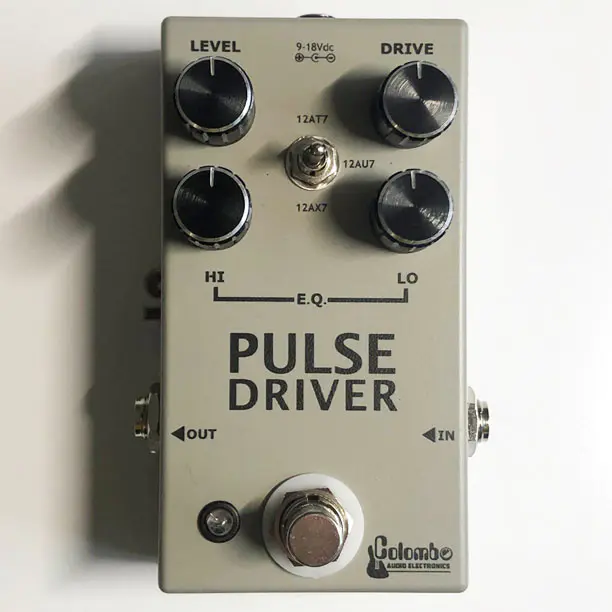
Hailing from Italy, the Colombo Audio Pulse Driver is a fully customizable overdrive inspired by the sound of the 1983 BK Butler combo amp, famously used by David Gilmour, Eric Johnson, Billy Gibbons and Joe Satriani among others.
The pedal recreates that 12AX7 tube design without an actual tube, recreating the sound of the original through two expertly configured (and much more consistent-sounding) solid-state stages that can actually recreate the response of 3 different tube types:
- 12AX7: the original tube found in the BK Butler, producing very high gain and very pronounced mid frequencies
- 12AU7: a classic mod to the amp, produced lower gain but a smoother response
- 12AT7: often used in the phase-inverter stages of vintage American amplifiers, it sounds like a cross between the previous tubes with a less pronounced gain and less invasive mid frequencies than a typical 12AX7, slightly more edgy and harsh than a 12AU7, perfect for crunchy crunch sounds.
The controls are pretty straightforward (Volume, Drive, Hi and Lo), have a listen to the Colombo Pulse Driver in the videos below.
Colombo Pulse Driver, Builder’s Notes
Pulse Driver goes beyond the normal conception of an overdrive pedal. Drawing heavily on the Chandler / B.K. Butler, the Tube Driver reincarnates much of the circuitry, solving the defects and imperfections of the latter without losing its typical sound.
Like all Colombo Audio Electronics pedals, Pulse Driver is also fully customizable. Based on customization requests, the price could change significantly.
One of the most frequently asked questions bycustomers in beta-testing and prototyping is:
“Why without a valve?”
The answer is quite simple but not so obvious, it’s therefore necessary to make a small premise: in the Tube Driver units the tube plays a fundamental role, generating a typically tube tone with unique warmth, this being one of the few tube-based pedals ever built to make the tube so important as it’s configured as a real gain stage, unlike the vast majority of tube pedals, where these are configured as cathode follower (basically a tube buffer).
However, installing such a tube inside a pedal can create a variety of noise issues. The use of an AC12V transformer in the original units doesn’t allow a total separation of the dual power supply (anode and heaters), the hum becomes really unbearable on some original units; this is the main reason for our choice to replace the tube with solid-state components.
“Does removing the tube will also lose the typical tube character of the Tube Driver?”
This is another recurring question, and the answer is partially positive: it’s not easy to reproduce the typical tube sound of the Tube Driver without the aid of a real tube. Our original idea, however, allowed us to get around the problem thanks to the same technology that we have used in other pedals in order to obtain the tube tone of the amp, such as Plexi Breed and Kensington, replacing the double triode with two expertly configured solid-state stages and not losing anything of the typical character of the Tube Driver, but to draw countless advantages from it:
• Unbeatable signal-to-noise ratio;
• Standard 9Vdc or 18Vdc power supply;
• More reliable circuit without maintenance;
• Possibility to reconfigure the “virtual tube” stage by recreating the response of 3 tube types.12AX7, 12AU7 and 12AT7
The Tube Driver became famous all over the world mainly for having been used (and still used today) by guitarists of the caliber of Eric Johnson and David Gilmour, the latter, as well as having made it a trademark since the 90s. onwards, he is known to have replaced the internal tube (originally a 12AX7) with a 12AU7 of all his Tube Driver units. This modification was later adopted by guitarists around the world, as simply replacing the tube gives the pedal a new voice. The toggle switch of the Pulse Driver accurately recreates the response of the 3 most used preamp tubes.12AX7: the most used tube in guitar preamps, used in most of the amplifiers and it’s the original tube mounted in the Tube Driver units. Characterized by a very high gain and very pronounced mid frequencies, perfect for strongly distorted and aggressive sounds;
12AU7: characterized by a medium / low gain and a velvety response, excellent for offering unmatched transparency and warm distortion without excesses and smudges;
12AT7: tube often used in the phase-inverter stages of vintage American amplifiers, it is the most atypical solution in this kind of device: a cross between the previous tubes with a less pronounced gain and less invasive mid frequencies than a typical 12AX7, slightly more edgy and harsh than a 12AU7, perfect for crunchy crunch sounds.Controls
Pulse Driver features an overdrive unit and an effective equalization unit (EQ).• Volume: controls the signal output level.
• Drive: determines the amount of input signal: low values ??give a clean sound that tends to saturated as this potentiometer is increased: the results change according to the position of the tube sound reconstruction lever;
• Hi: controls the amount of high frequencies;
• Lo: controls the amount of low frequencies;
• 12AX7, 12AU7, 12AT7: Allows you to choose the type of valve response.Power supply
The Pulse Driver draws about 8mA and works with a standard 9Vdc power supply (center negative) and can accept a voltage up to 18Vdc, recommended to obtaining a stronger tube response with even more headroom. There is no battery power supply.






















